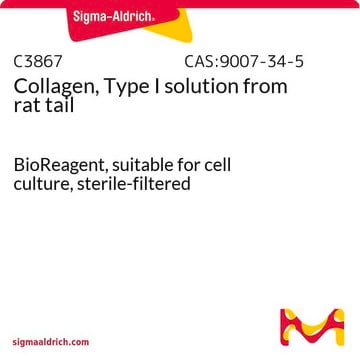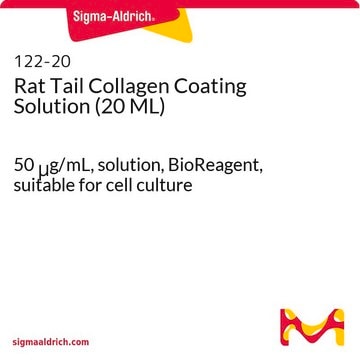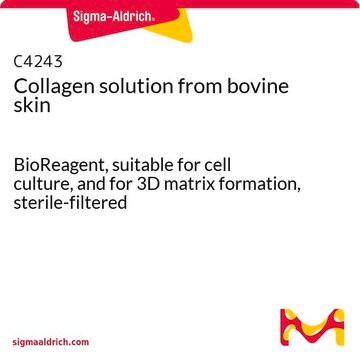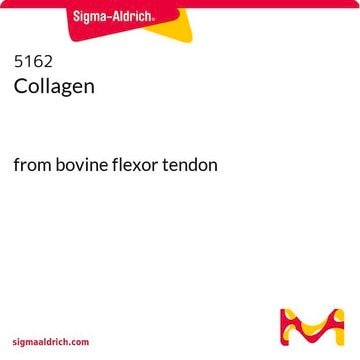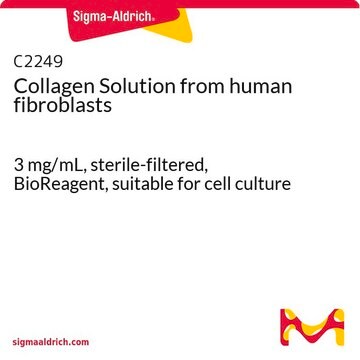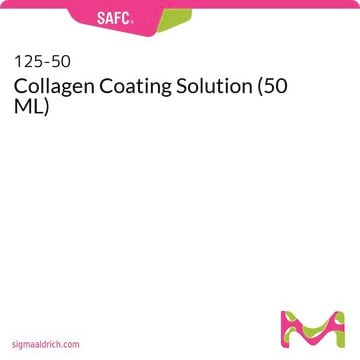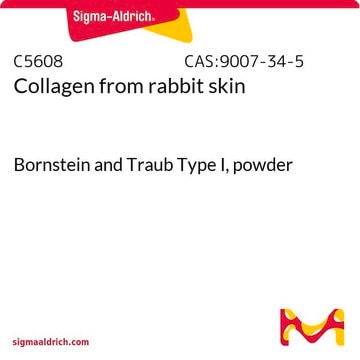As noted in the DESCRIPTION section of the product page, Collagen Type I is a very long, thin and abundant protein. It is a supercoiled right-helix of three left-handed polypeptide chains. These chains are composed of ~1040 amino acids, which are essentially repeats of three amino acids -(Gly-X-Y)n. Gly is glycine and X and Y can be any amino acids.
A defined molecular weight is not established, however when run on SDS page, multiple bands are observed at a range of 120 - 160 kDa. Please see the link below to the datasheet for this and other collagen products:
https://www.sigmaaldrich.com/deepweb/assets/sigmaaldrich/product/documents/133/320/c0543inf.pdf
C7661
Rat Collagen Type I
from rat tail, powder, suitable for cell culture
Sélectionner une taille de conditionnement
114,00 €
Sélectionner une taille de conditionnement
About This Item
114,00 €
Produits recommandés
Nom du produit
Collagène from rat tail, Bornstein and Traub Type I, powder, BioReagent, suitable for cell culture
Source biologique
rat tail
Niveau de qualité
Gamme de produits
BioReagent
Forme
powder
Poids mol.
120—160 kDa
Conditionnement
glass bottle of 5 mg
Technique(s)
cell culture | mammalian: suitable
Couverture de surface
6‑10 μg/cm2
Solubilité
soluble
Numéro d'accès NCBI
Numéro d'accès UniProt
Spécificité de la liaison
Peptide Source: Fibrinogen
Peptide Source: Laminin
Température de stockage
2-8°C
Informations sur le gène
rat ... Col1a1(29393)
Vous recherchez des produits similaires ? Visite Guide de comparaison des produits
Description générale
Application
- en immunohistochimie.[2]
- dans des essais d'activité cellulaire.[3].
- pour la génération de cultures d'explants de ganglion rachidien[4].
- comme l'un des constituants durant la préparation d'une surface fonctionnalisée (en montage RMN)[5].
- en culture cellulaire (lamelles de verre recouvertes de nanofils à hautes concentrations mélangés avec du collagène)[6].
- pour la biofonctionnalisation de microcanaux.[7]
Actions biochimiques/physiologiques
Notes préparatoires
Autres remarques
Code de la classe de stockage
11 - Combustible Solids
Classe de danger pour l'eau (WGK)
WGK 1
Point d'éclair (°F)
Not applicable
Point d'éclair (°C)
Not applicable
Équipement de protection individuelle
Eyeshields, Gloves, type N95 (US)
Faites votre choix parmi les versions les plus récentes :
Certificats d'analyse (COA)
Vous ne trouvez pas la bonne version ?
Si vous avez besoin d'une version particulière, vous pouvez rechercher un certificat spécifique par le numéro de lot.
Déjà en possession de ce produit ?
Retrouvez la documentation relative aux produits que vous avez récemment achetés dans la Bibliothèque de documents.
Les clients ont également consulté
Articles
The extracellular matrix (ECM) is secreted by cells and surrounds them in tissues.
Cancer stem cell media, spheroid plates and cancer stem cell markers to culture and characterize CSC populations.
-
How much is the molecular weight (dalton)?
1 answer-
Helpful?
-
-
What is the Department of Transportation shipping information for this product?
1 answer-
Transportation information can be found in Section 14 of the product's (M)SDS.To access the shipping information for this material, use the link on the product detail page for the product.
Helpful?
-
-
Why am I seeing some insolubles in my collagen solution?
1 answer-
The solubility specifications for this product is clear to hazy colorless solution with a few insolubles at 1 mg/ml in water with 2 μl acetic acid (or 0.1 N acetic acid). The insolubles can be removed by settling or centrifugation.
Helpful?
-
-
How can I sterilize collagen solutions?
1 answer-
We recommend transferring the collagen solution to a glass bottle with a screw cap and carefully layering chloroform at the bottom. The amount of chloroform to use should be ~10% of the volume of collagen solution. DO NOT SHAKE OR STIR. Allow to stand overnight at 2-8 °C. Aseptically remove the top layer containing the collagen solution to a new bottle. We do not recommend sterilizing the collagen solution by membrane filtration. We have found substantial protein loss by this method.
Helpful?
-
-
How can I make a 3-D collagen gel?
1 answer-
Not all lots of C7661 are suitable for 3D gels. Product No. C4243 has been use-tested in this application. If C4243 is not available, we recommend that customers screen lots of C7661 to try to make 3D gels. We have found that collagen that has been sterilized by gamma-irradiation or by chloroform cannot be used to make 3D collagen gels. The following protocol can be used to make collagen gels: Materials required:Collagen gel solution 1.5 - 3 mg/mL 10X tissue culture medium containing phenol red Sodium bicarbonate or HEPES buffer Procedure: 1.Measure out 800 μL of collagen solution. 2.Add 100 μL of 10X medium (buffered with 1X sodium bicarbonate or HEPES) 3.Adjust pH with 1 N sodium hydroxide, if required (100 μl or less) 4.Add 10X medium to bring volume to 1 ml 5.Mix contents well. Solution should maintain red color to indicate physiological pH6. Dispense into wells to a depth of 1-2 mm (approx. 15 μL/well) 7.Transfer to 37 °C for 20-40 minutes 8.Examine for gel formation The above volumes represent quantities for use in 24 well plates. Volumes can be adjusted to accommodate any culture vessel.
Helpful?
-
-
How are collagen solutions stored?
1 answer-
Collagen solutions should be stored in the refrigerator at 2-8 °C for up to 1 year, unless it becomes contaminated.
Helpful?
-
-
How long can collagen coated plates be stored?
1 answer-
We make no recommendations about storage of plates after coating. Since several factors such as humidity may impact longevity of coated plates, customers should make their own determination as to whether plates can be stored and under which conditions. We offer Sigma Screen collagen coated plates (Product No. S3315) that indicates the following: For optimal performance, the unopened product should be stored in a dry place at 2-8 °C. The product may be stored at room temperature for up to three months. The product should not be exposed to temperatures above 50 °C.
Helpful?
-
Active Filters
Notre équipe de scientifiques dispose d'une expérience dans tous les secteurs de la recherche, notamment en sciences de la vie, science des matériaux, synthèse chimique, chromatographie, analyse et dans de nombreux autres domaines..
Contacter notre Service technique